Propylene glycol: Educate yourself and your veterinary clients
The compound, used in pet food, human food and a variety of other products, is vilified by some, dismissed by others. But what is it, really?
Ever heard of propylene glycol? Sick of hearing about propylene glycol? Maybe you recognize it as an ingredient in “pet-friendly” antifreeze. Maybe you haven't given it a moment's thought until a recent lawsuit claimed it to be a toxic ingredient in Nestlé Purina's Beneful dog food and clients started asking-after consulting with the Internet, of course.
But do we really know what propylene glycol is-and what it does? Armed with information from reliable experts, you and your clients can make an educated decision on whether they should feed their pets food with propylene glycol on the ingredient list.
Read on for a refresher for yourself and your team and click here to download a client handout that explains propylene glycol to pet owners.
What is propylene glycol?
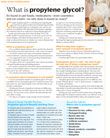
> “Propylene glycol is one of the least toxic glycols," says veterinary toxicologist Ahna Brutlag, DVM, MS, DABT, DABVT, associate director of veterinary services for Pet Poison Helpline. "It is a synthetic liquid substance that absorbs water and is used by the chemical, food and pharmaceutical industries for a wide variety of reasons." Brutlag says propylene glycol is commonly used to absorb extra water and maintain moisture in certain medicines, cosmetics and dog and human food products and is categorized by the U.S. Food and Drug Administration (FDA) as a "GRAS" (generally recognized as safe) substance for this use.
> Specifically, the FDA says propylene glycol is GRAS for use in animal feeds as a general-purpose food additive when used in accordance with good manufacturing and feeding practices.
> Propylene glycol is used as a solvent for food colors, flavors and pharmaceuticals (e.g. injectable diazepam) and is also used to create artificial smoke or fog used in theatrical productions. It is a colorless, nearly odorless liquid.
Is propylene glycol hazardous to pet health?
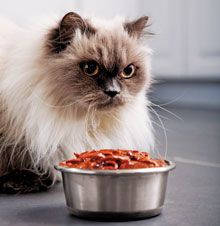
Getty Images> Cats are particularly sensitive to propylene glycol. The FDA prohibits the use of propylene glycol in cat foods because it has been shown to cause abnormalities in the red blood cells of cats fed diets containing it.
> Brutlag says that, historically, some semi-moist cat foods contained 5 to 10 percent propylene glycol, which caused Heinz body formation in cats. But because of significant interspecies differences, propylene glycol does not affect dogs in the same way, she says. The FDA concurs, saying it is not aware of any research that demonstrates the same effect on dogs.
> As with any chemical, it's the dose that makes the poison, Brutlag says. “If a dog or cat ingests a large enough amount of propylene glycol, it can become poisoned. The amount of propylene glycol that a dog would be expected to ingest in a commercial dog food containing propylene glycol would not be considered enough to cause poisoning. Propylene glycol is used in drugs and foods that veterinarians routinely give dogs for therapeutic intervention,” she says.
What if a dog does ingest a toxic amount of propylene glycol?
> Propylene glycol ingested at toxic doses can cause central nervous system depression and lactic acidosis, Brutlag says. The oral median lethal dose (LD50) of propylene glycol in dogs has been reported to be ~9 ml/kg body weight. Experimentally, propylene glycol administration in dogs at 2 g/kg/day has caused no adverse effects.
> According to Pet Poison Helpline, common signs to watch for with propylene glycol intoxication include severe sedation, ataxia (walking "drunk"), seizures, tremors, panting, anemia and lethargy.
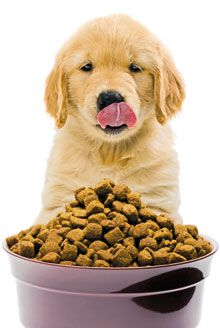
Getty ImagesWhy does propylene glycol get labeled as a dangerous toxin?
If the FDA generally recognizes propylene glycol as safe and veterinary toxicology experts agree that the small amount found in drugs and foods routinely given to dogs-and humans for that matter-is not harmful, why does propylene glycol still get a bad rap?
Brutlag believes that most misconceptions stem from the fact that propylene glycol is in the same chemical family and has a similar sounding name to ethylene glycol-the most common glycol responsible for poisonings. This, coupled with the fact that the compounds can be used similarly (e.g., both can be used as antifreeze), only adds to the confusion. Additionally, the fact that propylene glycol has historically been found to cause harm to cats when used in cat food can easily be misinterpreted as also causing harm to dogs when used in dog food. “Dogs are much less at risk than cats from many chemicals, propylene glycol included,” Brutlag says. “This fact is not always apparent, especially to those outside the field of veterinary medicine.”
Need a refresher? The clinical signs associated with ethylene glycol intoxication
> “In both dogs and cats, toxic doses of ethylene glycol cause CNS depression followed by acute kidney injury and metabolic acidosis,” Brutlag says. “Renal damage is thought to be secondary to calcium oxalate deposition, and crystalluria is a consistent finding in ethylene glycol poisoning. The minimum lethal dose of ethylene glycol is 4-6 ml/kg body weight in dogs.” According to Pet Poison Helpline, common signs of ethylene glycol poisoning occur in stages.
Stage 1: This occurs within 30 minutes to 12 hours and looks similar to alcohol poisoning. Signs include ataxia (walking "drunk"), drooling/hypersalivating, vomiting, seizuring, vomiting and excessive thirst and urination.
Stage 2: This occurs 12 to 24 hours after a dog or cat has gotten into antifreeze, and signs of “alcohol” poisoning appear to resolve while underlying severe internal damage is still occurring. Signs of drunkenness seem to improve, but elevated heart rate, increased breathing effort and dehydration may start to develop.
Stage 3: In cats, this stage occurs 12 to 24 hours after getting into antifreeze. In dogs, this stage occurs 36 to 72 hours after getting into antifreeze. During this stage, severe kidney failure is developing secondary to calcium crystals forming in the kidneys. Severe lethargy, coma, depression, vomiting, seizures, drooling and inappetance may be seen.
> Ethanol or 4-MP (fomepizole) are the only two antidotes for ethylene glycol or antifreeze poisoning. Cats must be treated within three hours of ingesting the compound, while dogs must be treated within eight to 12 hours of ingestion. Delayed treatment often is not effective, and once a dog or cat has developed kidney failure, the prognosis is poor.
> Propylene glycol, unlike ethylene glycol, does not cause kidney failure.
What is ethylene glycol?
> Although both propylene glycol and ethylene glycol are chemically classified as glycols and both are metabolized, as a first step, by the same enzyme in the liver (alcohol dehydrogenase), ethylene glycol has a much high toxicity.
> “Ethylene glycol is traditionally used for its ‘antifreeze' properties as its small molecular weight makes it highly effective for lowering the freezing point of water,” Brutlag says. Ethylene glycol can be found in highly concentrated amounts in automotive antifreeze and some windshield de-icing products and in small amounts in household products such as printer ink, interior and exterior paint, spackle, etc. Like ethylene glycol, propylene glycol may also be used as antifreeze and can be found in high concentrations in RV and “pet-friendly” antifreezes.
Nestlé Purina on propylene glycol
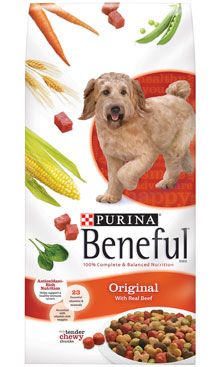
Photo courtesy of Nestlé Purina> According to Wendy Vlieks, director of corporate public relations for Nestlé Purina PetCare, USP propylene glycol concentrations in the Beneful diet are less than 2 percent.
> The Association of American Feed Control Officials (AAFCO) has no limit to the amount of propylene glycol in dog food, Vlieks says. The EU limit is 5.3 percent.
> Vlieks says the "no observed adverse effect level" (NOAEL) for propylene glycol is 8 percent of diet, meaning dogs fed at 8 percent propylene glycol in their diet for two years had no adverse effects.1
> Propylene glycol is found in Nestlé Purina's Beneful and some Dog Chow brands of dry dog food. "Propylene glycol functions as a humectant food additive and preservative. In other words, we use propylene glycol to help keep the semi-moist kibbles soft and moist," Vlieks says. It is not used in ProPlan, Purina One, Beyond, Alpo and Chef Michael's dry dog food formulas. "Beneful consumers love the variety of ingredients, which includes some kibble that is crunchy and some that is soft and moist. Propylene glycol is only an ingredient in varieties of Dog Chow that are softer, like for seniors, or have a mix of moist and crunchy kibble," Vlieks says. "The other brands just include hard crunchy kibble."
> Nestlé Purina pet foods, including Beneful, are "only released after we confirm all of the ingredients are included at the right levels. The ingredient inventory is also regularly reconciled as additional confirmation," Vlieks says.
> Purina's recommended daily feeding for Beneful Original dry dog food for adult dogs is as follows:
• Under 12 lbs., feed 1/2 to 1-1/4 cups
• 13 to 20 lbs., feed 1-1/4 to 1-2/3 cups
• 21 to 35 lbs., feed 1-2/3 to 2-1/2 cups
• 36 to 50 lbs., feed 2-1/2 to 3 1/4 cups
• 51 to 75 lbs., feed 3-1/4 to 4 cups
• 76 to 100 lbs., feed 4 to 5 cups
• More than 100 lbs., feed 5 cups plus 1/3 cup for each 10 lbs. of body weight beyond 100 lbs.
Reference
1. Weil CS, Woodside MD, Smyth HF Jr, Carpenter CP. "Results of feeding propylene glycol in the diet to dogs for two years," Food Cosmet Toxicol 1971 Aug;9(4):479-90.
Read on for where else you can find propylene glycol...
Read the labels: Where else can you find propylene glycol?
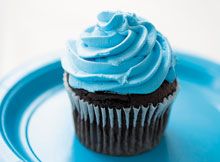
Getty Images> Ice cream (Cold Stone Creamery, Blue Bunny Sweet Freedom Vanilla Ice Cream Cones, Edy's Slow Churned Peppermint Wonderland)
> Flavored ice tea (Dunkin' Donuts flavored iced tea, Nestea Liquid Water Enhancers)
> Flavored coffee
> Packaged frosting (some Betty Crocker varieties)
> Boxed cake mix (Betty Crocker and Duncan Hines)
> Salad dressings
> Artificial sweetners
> Medications
> Deodorant
> Skin care products, hair care products and cosmetics
> Baby wipes
> Margarine